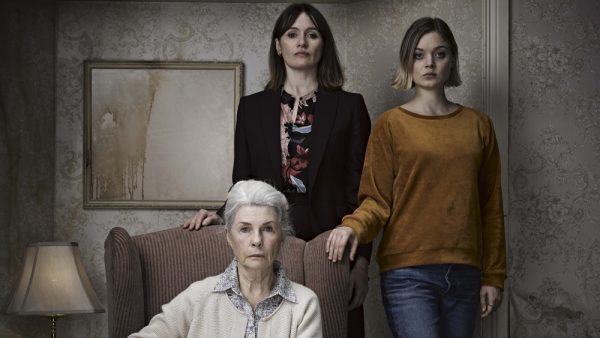Film Review: “Relic” — The Future Is Female, and So Is the Past
By Peg Aloi
Relic draws on the debilitations of both time and space: the inevitable aging of the body and the places we call home, the inescapable repositories of memories, regrets, and the unknown.
Relic, directed by Natalie Erika James. Streaming on Amazon Prime

Robyn Nevin, Emily Mortimer, and Bella Heathcote in Relic.
Horror is hot. Streaming options for movies and television mean an almost unending supply of new horror stories. Understandably, the quality of the storytelling can’t keep up with the quantity. As a lover of excellence in cinema and TV, I’m often overwhelmed by all the new material, and I’m also sometimes disappointed, mainly by writing that is poorly executed, derivative, or unoriginal. The good news is that there have been so many great indie horror films over the last five years that I’m consistently compelled to keep seeking out the gems.
Along with an uptick in horror genre narratives, there are sub-genres that continue to grow and attract attention, as well as tropes that spawn their own genres. The latter include folk horror, body horror, and psychological horror. Another cinematic trend has been a focus on the experiences of women: their stories, their concerns and possibilities — emotional, physical, and cultural. Increasingly women writers and directors are helming such films. Some fit squarely in the horror genre, like Jennifer Kent’s The Babadook or Ana Lily Amirpour’s A Girl Walks Home Alone at Night. Some skirt the edges of horror, such as the disturbing work of Lynne Ramsay, or explore hybrid possibilities, such as Jennifer Reeder’s Knives and Skin, Julia Duconrneau’s Raw, and Shannon Murphy’s Babyteeth, all of which also function as coming-of age-stories. Then there is Emma Tammi’s The Wind, a sort of horror western.
I used to teach a course on Australian Cinema and, at the time, the country wasn’t particularly known for its horror films. Indie hit Wolf Creek (2005) changed that. Since then, Australian horror offerings have become increasingly intriguing, even trendsetting. Natalie Erika James’s feature debut, Relic, an atmospheric and quietly compelling horror tale, is very much a part of that movement. Co-written with Christian White, James’s horror film draws on the debilitations of both time and space: the inevitable aging of the body and the places we call home, the inescapable repositories of memories, regrets, and the unknown.
As the film opens, an Australian woman and her teenage daughter travel to the family matriarch’s home because she has been reported missing. Emily Mortimer is Kay; her mother Edna (Robyn Nevin) has been living on her own in the family home for many years since her husband died. Kay and daughter Sam (Bella Heathcote) arrive to find Edna’s house in slight disarray; there are no signs of where she might have gone. Then, suddenly, she reappears, asking Kay if she wants a cup of tea. Kay is startled and asks Edna where she’s been; Edna doesn’t understand why anyone thinks she has been missing. This is the first sign we’re in horror territory; the moment is not supernatural, but it is mysterious and unsettling.
Kay and Sam plan to stay a few days and help Edna sort some things out. Seeing that her mother is in a somewhat confused state, which includes some occasional outbursts, Kay becomes visibly shaken. But she treats Edna gently and respectfully. As they do some cleaning and organizing, Kay and Sam see a lifetime of accumulated memories and objects in Edna’s home, and realize others would be overwhelmed at the scale of it. The house needs a few repairs, and it’s clear some rooms haven’t been entered in a while. Others look merely dusty and cluttered. Disturbingly, they find Post-It notes stuck to walls, mirrors, boxes, their messages both mundane and cryptic. When Kay mentions the notes, Edna responds tersely: “It’s my house and I can decorate it however I want.”
There is tension between Kay and Sam over what to do about Edna’s condition: Sam offers to come and live with Edna and help her. At first, Edna welcomes this decision, but then she becomes suspicious and hostile. Her encroaching dementia becomes evident, the cause of her mood swings and confusion. There are signs of physical decline also, including a large bruise that becomes darker and more gruesome as the days pass. Kay tries to dress the wound, but its intense growth begins to frighten her. Sam explores hidden spaces in the house that seem hard to escape from. These encounters with physical enclosure and bodily grotesqueness come closest to standard horror film territory. More powerful is the use of a surrealism that suggests we’re sharing Edna’s tenuous grip on reality. The sound design and music are subtle and eerily effective; a mood is created that intensifies slowly and suspensefully. Even more frightening is the narrative’s suggestion that our own sense of time and place will one day, like Edna’s, become unmoored and unreliable. That at some point we will not be able to control our bodies or thoughts.
Though Relic’s central metaphors loom large, they never seem forced or unwieldy. The three actresses are utterly believable as three generations of women struggling to do their best by one another. Notably, no men are present or even mentioned. In addition to its rather gloomy outlook on aging, James’s provocative debut digs deep into the often neglected but heart-wrenching reality of women as caregivers. Mothers caring for children, grandmothers caring for grandchildren, daughters caring for aging mothers and grandmothers. In this old house, some of its hidden corners and crevices mouldering and collapsing, an ancient cycle is being played out, one that repeats from one generation to the next. It is a world filled with mementos: clothing, photographs, letters, dishes, jewelry, and toys. All these are talismans tethering us to times and spaces that are long gone. The invisible bonds of family, the boundless limits of love, hover in the shadowy corners of the territories we call “home,” the places that know, remember — and frighten — us.
Peg Aloi is a former film critic for the Boston Phoenix and member of the Boston Society of Film Critics. She taught film studies in Boston for over a decade. She writes on film, TV, and culture for web publications like Vice, Polygon, Bustle, Mic, Orlando Weekly, Crooked Marquee, and Bloody Disgusting. Her blog “The Witching Hour” can be found at themediawitch.com.
Tagged: Bella Heathcote, Emily Mortimer, Natalie Erika James, Peg Aloi, Relic

